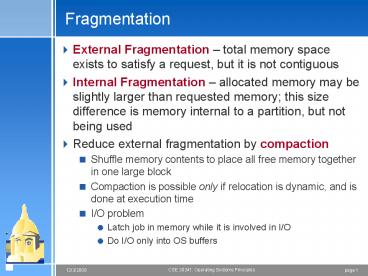Fragmentation - PowerPoint PPT Presentation
1 / 22
Title:
Fragmentation
Description:
External Fragmentation total memory space exists to satisfy a ... noncontiguous ... a process can be noncontiguous; process is allocated physical ... – PowerPoint PPT presentation
Number of Views:141
Avg rating:5.0/5.0
Title: Fragmentation
1
Fragmentation
- External Fragmentation total memory space
exists to satisfy a request, but it is not
contiguous - Internal Fragmentation allocated memory may be
slightly larger than requested memory this size
difference is memory internal to a partition, but
not being used - Reduce external fragmentation by compaction
- Shuffle memory contents to place all free memory
together in one large block - Compaction is possible only if relocation is
dynamic, and is done at execution time - I/O problem
- Latch job in memory while it is involved in I/O
- Do I/O only into OS buffers
2
Paging for noncontiguous allocation
- Logical address space of a process can be
noncontiguous process is allocated physical
memory whenever the latter is available - Divide physical memory into fixed-sized blocks
called frames (size is power of 2, between 512
bytes and 8192 bytes) - Divide logical memory into blocks of same size
called pages. - Keep track of all free frames
- To run a program of size n pages, need to find n
free frames and load program - Set up a page table to translate logical to
physical addresses - This scheme will create internal fragmentation
3
Address Translation Scheme
- Address generated by CPU is divided into
- Page number (p) used as an index into a page
table which contains base address of each page in
physical memory - Page offset (d) combined with base address to
define the physical memory address that is sent
to the memory unit
4
Address Translation Architecture
5
Paging Example
6
Paging Example
7
Free Frames
Before allocation
After allocation
8
Implementation of Page Table
- Page table is kept in main memory
- Page-table base register (PTBR) points to the
page table - Page-table length register (PRLR) indicates size
of the page table - In this scheme every data/instruction access
requires two memory accesses. One for the page
table and one for the data/instruction. - The two memory access problem can be solved by
the use of a special fast-lookup hardware cache
called associative memory or translation
look-aside buffers (TLBs)
9
Associative Memory
- Associative memory parallel search
- Address translation (A, A)
- If A is in associative register, get frame out
- Otherwise get frame from page table in memory
Page
Frame
10
Paging Hardware With TLB
11
Effective Access Time
- Associative Lookup ? time unit
- Assume memory cycle time is 1 microsecond
- Hit ratio percentage of times that a page
number is found in the associative registers
ration related to number of associative registers - Hit ratio ?
- Effective Access Time (EAT)
- EAT (1 ?) ? (2 ?)(1 ?)
- 2 ? ?
12
Memory Protection
- Memory protection implemented by associating
protection bit with each frame - Valid-invalid bit attached to each entry in the
page table - valid indicates that the associated page is in
the process logical address space, and is thus a
legal page - invalid indicates that the page is not in the
process logical address space
13
Valid (v) or Invalid (i) Bit In A Page Table
14
Page Table Structure
- Problem is that page tables are per-process
structure and they can be large. Discuss for 64
bit architecture. - Hierarchical Paging
- Hashed Page Tables
- Inverted Page Tables
15
Hierarchical Page Tables
- Break up the logical address space into multiple
page tables - A simple technique is a two-level page table
16
Two-Level Paging Example
- A logical address (on 32-bit machine with 4K page
size) is divided into - a page number consisting of 20 bits
- a page offset consisting of 12 bits
- Since the page table is paged, the page number is
further divided into - a 10-bit page number
- a 10-bit page offset
- Thus, a logical address is as followswh
ere pi is an index into the outer page table, and
p2 is the displacement within the page of the
outer page table
page number
page offset
pi
p2
d
10
12
10
17
Two-Level Page-Table Scheme
18
Address-Translation Scheme
- Address-translation scheme for a two-level 32-bit
paging architecture
19
Hashed Page Tables
- Common in address spaces gt 32 bits
- The virtual page number is hashed into a page
table. This page table contains a chain of
elements hashing to the same location. - Virtual page numbers are compared in this chain
searching for a match. If a match is found, the
corresponding physical frame is extracted.
20
Hashed Page Table
21
Inverted Page Table
- One entry for each real page of memory
- Entry consists of the virtual address of the page
stored in that real memory location, with
information about the process that owns that page - Decreases memory needed to store each page table,
but increases time needed to search the table
when a page reference occurs - Use hash table to limit the search to one or at
most a few page-table entries
22
Inverted Page Table Architecture

